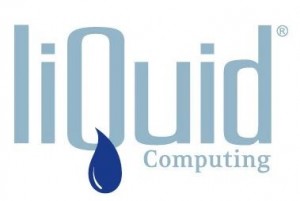Flashback to April 2006 – Liquid Computing

In the lobby at Liquid Computing, a monitor rolls a slide show of the company’s markets, product line architecture, and advantages. Their target buyers are users who need High Performance Computing (HPC) – like scientists doing calculations on global climate change, or engineers doing simulations of the power and noise levels generated by a new design of a jet engine. Yes, this is rocket science! The company mission is to deliver scalable computing without compromise. It is sharply focused on solving key computing challenges that have plagued the scientific & research, defense, biosciences, mechanical design, and geosciences communities.” The product line is positioned as being best for buyers who need both “High performance” and “High flexibility” computing. When Andy Church, VP Marketing and Alliances, met with me he filled me in.
Market targeting – Church commented, “We are focused on gaining HPC customer traction in Government Research Labs and the University sector, Defense, Biosciences and Energy. We are also spending some of our focus in adjacent markets such as Application Service Providers, Enterprise and Telecom OEM. As one would expect, we are following the 80/20 rule in terms of managing our resources, outreach and overall focus – we invest 80% of the marketing effort on chosen markets; 20% in selected adjacent markets.”
Start-up “enablers” – Additional insight was gleaned when Bob Garrow, Senior VP Strategic Relationships discussed startup success factors as keynote speaker at a recent dinner meeting of The Ottawa Network (TON). He identified timely “enablers” as a key startup success ingredient. Garrow is based in Silicon Valley (Los Altos). He worked with Intel in the early years, as well as Convergent (as a co-founder) and Sun Microsystems. Enablers are technical and market milestones that have been achieved, that make a significant new innovation possible, timely, and likely to succeed. For Liquid Computing, the enablers are the 64-bit processors and their hi-speed interfaces, the new operating systems available (standard. Linux), telecom architectures applied to general computing design (reliable, scalable, low human resource to operate and no disruption to expand or repair), inside-out design principles (start with solving interconnect bottlenecks, then inject processor performance), and the availability of key engineering expertise that was previously not available.
Defining a new product category – Church is well aware of market entry dynamics. Buyers position a new offer with reference to things they already know, and third parties (analysts, media, thought leaders) write about trends in technology – with special fondness for the emergence of a new category. It gives them something new to write about; something to nurture their reputation as a leader in their corner of the industry. Hence the creation of a product’s identity involves two things – naming the product, and choosing the category. Choosing an existing category makes sense when your new product has competitive advantage over existing players – and you aim to win over similar products based on feature set or cost. Choosing a new category makes more sense when you plan to offer a distinctively different way to solve a problem – and you wish to compete against the entire existing paradigm. What marketers call “the discussion” in the marketplace will shift to the new category, referring to it as a new paradigm, and giving you lots of free attention as a leader in the new space. This shift in market attention draws funding, and user spending, out of old categories into your new one. The Sports Utility Vehicle (“SUV”) category is an example of masterful category definition in the auto sector, and has shifted billions of dollars of spending from adjacent categories such as mini-vans and upscale sedans.
At Liquid Computing, Church has put an excellent set of set of category ideas in play, choosing to position their products in a new category, identified as “Interconnect Driven Server” (IDS), actively participating in naming the new category, and creating market awareness of the attributes of the new category.
High-level product definition – Bottlenecks at the heart of current computer architectures are the key barrier to better design of high performance computing. The founders first looked at the sources of these bottlenecks – processor to memory bandwidth, and processor to processor bandwidth and control problems, and developed a new system architecture for optimum interconnect (hence the category name “Interconnect-Driven Server”). Then processors and memory were added, in such as way as to allow easy scale out and scale-up (or scale-down) of processing power. The effect is to provide architecture with far better performance, and better price-performance, for high performance computing users and several other users in adjacent markets.
Finding “early adopters” – Many influential high performance users are in the national labs in the USA, and Liquid was able to get speaking engagements at key conferences, including a key event at the Oak Ridge National Laboratory in Tennessee, to a conference of high performance computing users. Those audiences included many of the early adopters and thought leaders, and have served to give Liquid Computing introductions that attracted early adopters and lead customers, giving them a seat at the table as detailed engineering and market positioning were developed.
First product shipments are expected soon, and this will be a company and category to watch over the next few years.
This article by Peter Fillmore, was originally published in SCAN – MARKETECH in April 2006.



Follow Us
Follow us on LinkedIn for updates.